
Introduction
The Department of Consumer and Business Services (the department)
was given full responsibility by the Oregon Safe Employment Act
of 1973 "... to assure as far as possible safe and healthful
working conditions for every working man and woman in Oregon..."
in accordance with the Federal Occupational Safety and Health
Act of 1970. Since 1971 the department, in cooperation with the
U.S. Bureau of Labor Statistics, has conducted an annual survey
of occupational injuries and illnesses. In 1976 the federal grant
was amended to include the collection of data directly from workers'
compensation cases. Each year since 1976 the department has published
a report summarizing the characteristics of the year's accepted
disabling claims (see the notes for definitions). This report
summarizes the changes in the characteristics of Oregon's workers'
compensation claims from 1976 to 1996. The yearly claims characteristics
publications, other reports covering Oregon's workers' compensation
system, and the department's overall statistical summary, Monitoring
the Key Components of Legislative Reform, are available upon
request.
Claims and claims rates
The recent history of Oregon's workers' compensation system can
be divided into two periods. Prior to 1989, the trends in the
number of workers' compensations claims were exaggerated versions
of Oregon's economic trends. In the 1970s and early 1980s, when
the employment growth slowed, the number of accepted disabling
claims fell (see Table 1). When the economy recovered, the number
of accepted disabling claims increased at a faster rate than
did employment. One explanation for this pattern is that inexperienced
workers, who are more likely than experienced workers to be injured,
are also more likely to be fired during economic downturns and
hired during economic upswings.
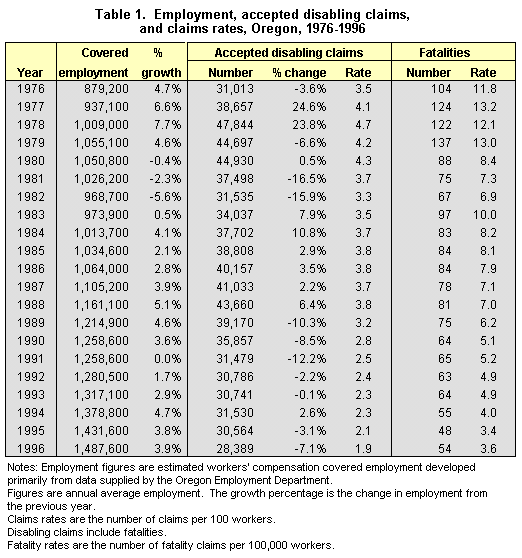
In part because of the growth in the number of claims, Oregon's workers' compensation system was overhauled between 1987 and 1990. During the 1987 legislative session, HB 2900 expanded OR-OSHA's consultative program, required insurers and self-insured employers to provide safety and health loss prevention programs, and increased penalties against employers who violated the state safety and health act. In 1990, continued high workers' compensation costs and the cancellation of the policies of many small employers provided the impetus for further reform. This effort culminated in the passage of SB 1197 during a special session of the Oregon legislature. SB 1197 extended HB 2900 by requiring that all employers with more than ten employees establish safety and health committees and that employers with ten or fewer employees establish safety committees if they had a lost workday cases incidence rate in the top ten percent of rates for employers in the same industry or were subject to a premium classification in the highest 25 percent of premium rates.
In SB 1197, the legislature also changed the definitions of compensability for both injuries and diseases. The reforms required that a compensable injury be established by medical evidence supported by objective findings. In addition, the compensable injury had to be the major contributing cause of a consequential condition for that condition to be compensable. If the compensable injury was combined with a preexisting condition, the resultant condition was compensable only to the extent that the compensable injury remained the major contributing cause of the disability or need for treatment. Injuries from recreational and social activities were excluded. Injuries that arose from the use of alcohol or drugs were excluded when it was proved by clear and convincing evidence that the alcohol or drug was the major contributing cause of the injury. (In 1995, the legislature reduced the standard of proof to the “preponderance of evidence.”) Likewise, the definition of a compensable occupational disease was changed. To be compensable, the disease had to be caused by substances or activities to which an employee was not ordinarily subjected, the employment had to be the major contributing factor, and the existence of the disease had to be established by objective medical evidence.
Legislative reforms and the increased number of safety committees have not been the only changes. Oregon employers obtain workers’ compensation insurance from private insurers or the SAIF Corporation, or they choose to be self-insured. Between 1989 and 1991, SAIF dropped the coverage of a large number of small employers and instituted claims handling procedures that resulted in a higher claims denial rate. More recently, changes in claims management by insurers and employers, such as return-to-work programs that help employees get back to work quickly, may be reducing the number of accidents that are classified as accepted and disabling.
Also, Oregon’s economy has changed over the past 20 years. There are fewer workers in the hazardous wood products industry, and more workers in comparatively safer services industries. Although this employment shift has had some effect, claims rates have declined in all industries, and the available information indicates that this economic shift has had a fairly small role in the recent reductions in the number of claims.
These factors have helped to recreate Oregon's workers' compensation environment. In most recent years, Oregon has had a slowly decreasing number of accepted disabling claims coming from an expanding pool of workers. Between 1988 and 1996, the number of workers covered by Oregon's workers' compensation law increased 28 percent, and the number of accepted disabling claims declined 35 percent. Because of this pattern, the claims rate fell from 3.8 claims per 100 workers in 1988 to 1.9 in 1996.
Industries and occupations
Claims counts and rates for Oregon's industry divisions and important
industries within divisions are shown in Table 2. To some degree,
the changes in the distribution of claims reflect the changes
in Oregon's mix of industries. The changes in claims rates show
that safety has increased in all industries.
In 1976, 42 percent of the accepted disabling claims came from the manufacturing division; in 1996, 21 percent came from manufacturing. The largest drops in claims have come from the wood products and food products industries. In 1976, the wood products industry produced 20 percent of the claims and 38 percent of the fatalities; in 1996, it had seven percent of the claims and 22 percent of the fatalities.
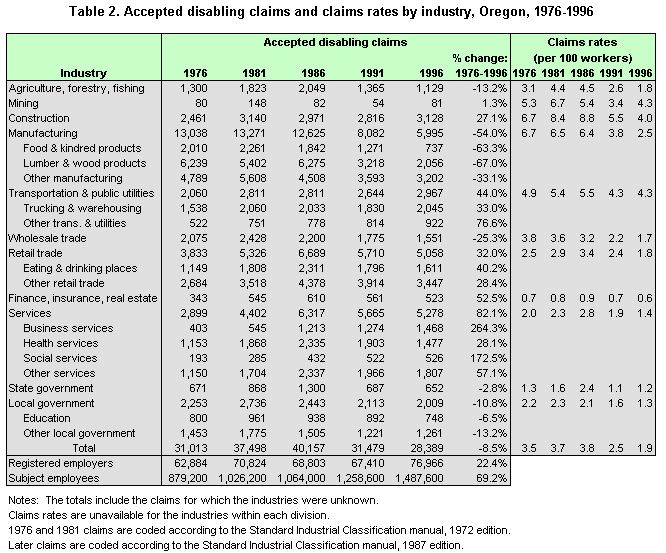
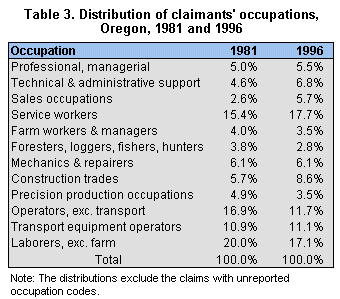 The
shift in the industries of injured workers is seen to a lesser
extent in the shift in claimants' occupations (see Table 3).
There has been a decline in the percentage of workers whose occupations
are chiefly manufacturing jobs: precision production occupations
and non-transport machinery operators. Also, in 1981, 41 percent
of the injured non-farm laborers were in the manufacturing division;
in 1996, 22 percent of the non-farm laborers worked in manufacturing.
The
shift in the industries of injured workers is seen to a lesser
extent in the shift in claimants' occupations (see Table 3).
There has been a decline in the percentage of workers whose occupations
are chiefly manufacturing jobs: precision production occupations
and non-transport machinery operators. Also, in 1981, 41 percent
of the injured non-farm laborers were in the manufacturing division;
in 1996, 22 percent of the non-farm laborers worked in manufacturing.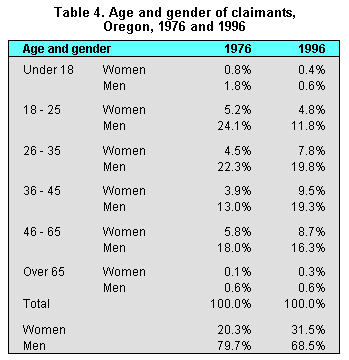 One
of the important trends in Oregon's worker' compensation system
has been the steady decline in the wages of injured workers compared
to the wages of all Oregon workers. In 1981, the average weekly
wage (AWW) of an injured worker was $18.70 higher than the statewide
AWW (see Table 5). In 1996, the AWW of injured workers was $78.03
less than the statewide average.
One
of the important trends in Oregon's worker' compensation system
has been the steady decline in the wages of injured workers compared
to the wages of all Oregon workers. In 1981, the average weekly
wage (AWW) of an injured worker was $18.70 higher than the statewide
AWW (see Table 5). In 1996, the AWW of injured workers was $78.03
less than the statewide average.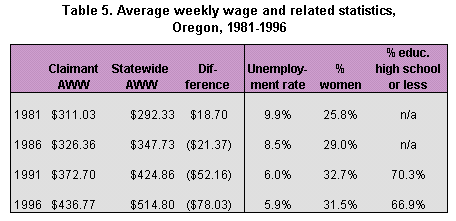 The
second explanation for the increasing wage differential was the
increasing percentage of injured workers who were women. On average,
women have earned less than men. Therefore, as the percentage
of injured workers who were women grew closer to the percentage
of all Oregon workers who were women, the wage differential should
have grown. Again, however, this explanation doesn't hold true
during the 1990s. The percentage of women in Oregon's work force
has increased, while the percentage of the injured population
who are women has declined.
The
second explanation for the increasing wage differential was the
increasing percentage of injured workers who were women. On average,
women have earned less than men. Therefore, as the percentage
of injured workers who were women grew closer to the percentage
of all Oregon workers who were women, the wage differential should
have grown. Again, however, this explanation doesn't hold true
during the 1990s. The percentage of women in Oregon's work force
has increased, while the percentage of the injured population
who are women has declined.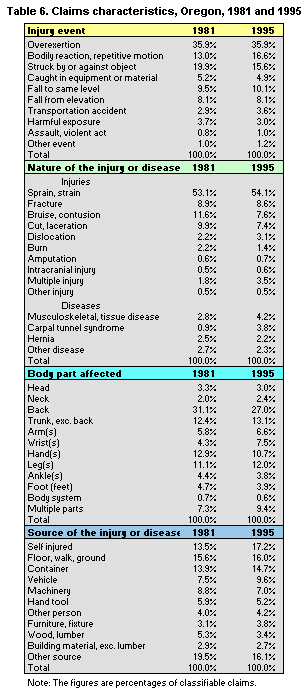 The
top portion of the table shows the events that caused the claims
in 1981 and 1995. In both years, 36 percent of the claims resulted
from overexertion. An increasing percentage of the claims are
from bodily reaction (where a single incident of bodily motion
causes a strain upon the worker's body) and repetitive motion
(where multiple incidents of bodily motion cause strain). A smaller
portion of the claims now result from workers being struck by
objects or against objects. These claims are more often likely
to occur in the manufacturing industry, especially in the logging
industry, so this decline reflects the change in the industrial
mix.
The
top portion of the table shows the events that caused the claims
in 1981 and 1995. In both years, 36 percent of the claims resulted
from overexertion. An increasing percentage of the claims are
from bodily reaction (where a single incident of bodily motion
causes a strain upon the worker's body) and repetitive motion
(where multiple incidents of bodily motion cause strain). A smaller
portion of the claims now result from workers being struck by
objects or against objects. These claims are more often likely
to occur in the manufacturing industry, especially in the logging
industry, so this decline reflects the change in the industrial
mix.